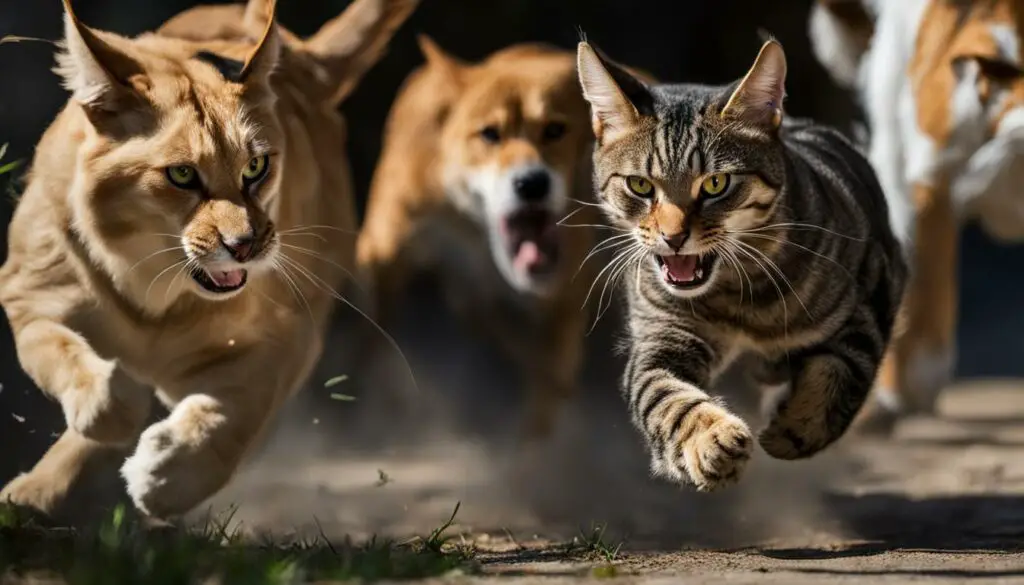As a pet owner, I’ve often wondered why cats sometimes hit dogs. It can be quite puzzling to witness these interactions between two seemingly adorable pets. But there’s more to it than meets the eye. To truly understand why cats hit dogs, we need to delve into the complex world of feline behavior and uncover the mysteries behind it.
When it comes to cat-dog interactions, there are various factors at play. Cats may bully dogs out of fear, insecurity, or a desire for attention. They may also feel threatened, lack proper socialization, or want to establish dominance. Understanding these underlying reasons can help us create a harmonious living situation for our beloved feline and canine companions.
Key Takeaways:
- Understanding the reasons behind cat-dog interactions can help create a harmonious living situation.
- Cats may hit dogs out of fear, insecurity, or a desire for attention.
- Threat perception, socialization, and dominance play a role in cat-dog conflicts.
- Proper training, management, and care are essential for maintaining a peaceful coexistence.
- Building a strong bond between cats and dogs requires understanding their behavior and needs.
The Complex Relationship Between Cats and Dogs
Cats and dogs have long been considered natural adversaries, but their dynamic is far more complex than meets the eye. While some cats and dogs may live harmoniously together, others may experience conflicts and aggression. Understanding the factors that contribute to these interactions is crucial for creating a peaceful coexistence.
Feline aggression towards canines can stem from various reasons. Cats may perceive dogs as a threat to their territory or may feel the need to assert their dominance. Additionally, cats may display aggressive behavior towards dogs if they feel fearful, insecure, or lack proper socialization. These underlying motivations can play a significant role in shaping their interactions and behavior towards each other.
It is essential to acknowledge that not all cats and dogs will have negative interactions. Many factors, such as individual personalities, past experiences, and environmental factors, can influence their relationship. Some cats and dogs may even form strong bonds and engage in playful interactions. By understanding the complexities of their relationship, pet owners can better manage and alleviate conflicts, ensuring a peaceful and harmonious environment for both pets.
“The complex relationship between cats and dogs can be attributed to various factors, including territorial instincts, fear, and the need to establish dominance.”
By fostering positive and controlled introductions, providing separate spaces, and offering enrichment activities, pet owners can create an environment that promotes amicable interactions between cats and dogs. Additionally, professional guidance from animal behaviorists or trainers can be invaluable in understanding and addressing any conflicts that may arise. With patience, consistency, and a deep understanding of their behavior, cats and dogs can learn to coexist harmoniously, fostering a strong bond between them and their human companions.
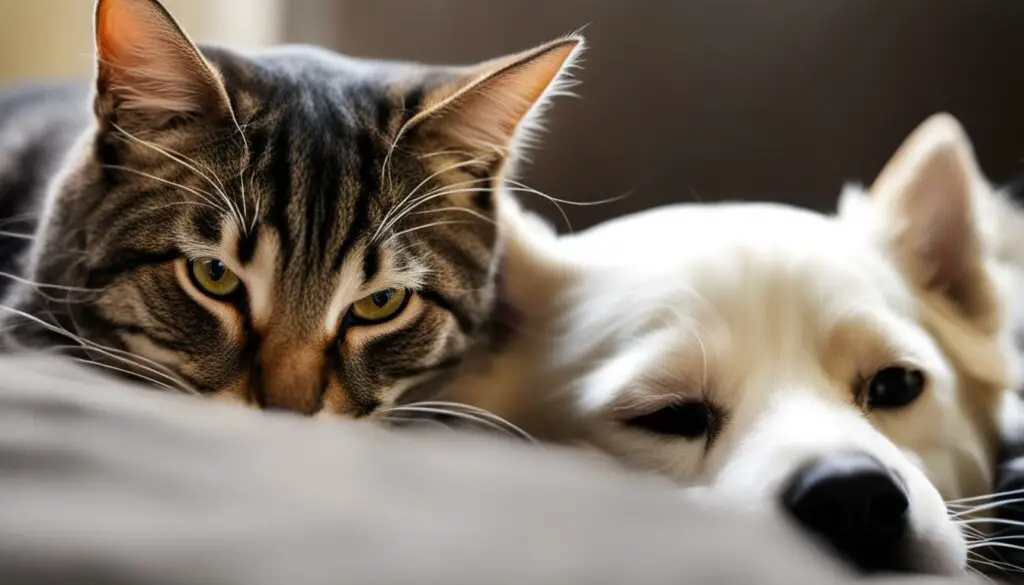
| Reasons for Cats Hitting Dogs | Factors Influencing Interactions | Strategies for Managing Cat-Dog Relationships |
|---|---|---|
| Fear and insecurity | Introducing pets slowly and gradually | Providing separate spaces for each pet |
| Desire to assert dominance | Understanding individual personalities | Offering enrichment activities and toys |
| Perceived threat to territory | Seeking professional guidance if needed | Consistency in training and positive reinforcement |
Creating a harmonious relationship between cats and dogs is a journey that requires patience, understanding, and proactive efforts. By recognizing the complex dynamics between these two species, we can ensure a safe and enriching environment for both pets, allowing them to thrive together as valued members of our families.
Why Cats Bully Dogs
Cats bullying dogs is not uncommon and can be attributed to various factors. Understanding these reasons is crucial for managing cat-dog relationships and preventing conflicts. Here are some key factors that contribute to cats bullying dogs:
- Fear and Insecurity: Cats may bully dogs out of fear or insecurity. A dog’s size and energy levels can intimidate a cat, leading to defensive behavior such as hissing, swatting, or biting. Creating a safe space for the cat and gradually introducing them to the dog can help alleviate their fear and reduce instances of bullying.
- Desire for Attention: Some cats may resort to bullying behavior as a means of seeking attention. They may feel neglected or jealous of the attention given to the dog and act out to regain the spotlight. Providing ample individual attention and playtime to both pets can help address this issue.
- Threat Perception: Cats are territorial animals, and the presence of a dog in their space can be perceived as a threat. The cat may resort to bullying behavior to establish dominance and protect its territory. Slow and supervised introductions, along with clear boundaries and separate resting areas, can help mitigate territorial conflicts.
- Lack of Socialization: Cats that have not been properly socialized with other animals, including dogs, may exhibit bullying behavior. Early socialization and gradual exposure to dogs and other pets can help cats feel more comfortable and reduce the likelihood of aggression.
It is important to note that every cat and dog is unique, and the reasons for bullying behavior may vary. Observing their behavior, consulting with a veterinarian or animal behaviorist, and implementing appropriate training and management techniques can greatly improve the dynamics between cats and dogs.
“Understanding the underlying reasons for cat-dog conflicts is crucial for preventing and addressing bullying behavior. By addressing fear, insecurity, and providing appropriate attention, socialization, and boundaries, pet owners can create a harmonious living environment for their feline and canine companions.” – Dr. Sarah Thompson, Animal Behaviorist
It’s essential to prioritize the well-being and safety of both pets when managing cat-dog relationships. Addressing the root causes of bullying behavior and providing a supportive environment can help cats and dogs coexist peacefully.
| Factors | Solutions |
|---|---|
| Fear and Insecurity | Create a safe space, gradual introductions, positive reinforcement |
| Desire for Attention | Provide individual attention, playtime, and enrichment |
| Threat Perception | Slow and supervised introductions, separate resting areas |
| Lack of Socialization | Early socialization, gradual exposure to dogs and other pets |
By implementing these strategies and understanding the underlying reasons behind cat-dog conflicts, pet owners can create a peaceful and harmonious environment for their furry companions.
The Feline Mindset Towards Dogs
Understanding the feline mindset towards dogs is crucial for managing cat and dog interactions and preventing feline aggression towards other pets. Cats have a unique way of perceiving their environment and interacting with other animals, which is influenced by their evolutionary history and territorial nature.
Cats are natural predators and have retained their hunting instincts, even in domestic settings. They are territorial animals that establish and defend their personal space. When dogs enter their territory, cats may perceive them as a threat, leading to aggressive behaviors such as hissing, swatting, or even scratching.
Cats also have a highly sensitive sense of smell, which allows them to detect scents and pheromones left by other animals, including dogs. These scents can trigger territorial responses in cats, as they mark their territory to establish dominance and ensure their safety.
To manage the feline mindset towards dogs, it is important to provide cats with their own designated spaces and resources, such as separate feeding areas and litter boxes. This helps alleviate territorial conflicts and reduces the likelihood of aggressive behaviors. Additionally, gradual and supervised introductions between cats and dogs, along with positive reinforcement training, can help foster positive interactions and build a harmonious relationship between the two species.
The Feline Mindset Towards Dogs
| Factors Influencing Feline Behavior Towards Dogs | Effects on Interactions |
|---|---|
| Territorial Instincts | Aggressive behaviors towards dogs entering their territory |
| Sensitivity to Smell | Reacts to scents and pheromones left by dogs |
| Establishing Dominance | Marking territory to assert dominance and ensure safety |
Understanding the feline mindset towards dogs is the key to promoting peaceful coexistence between these two species. By providing cats with their own space and resources, and facilitating gradual introductions and positive interactions, we can create a harmonious environment for both cats and dogs.
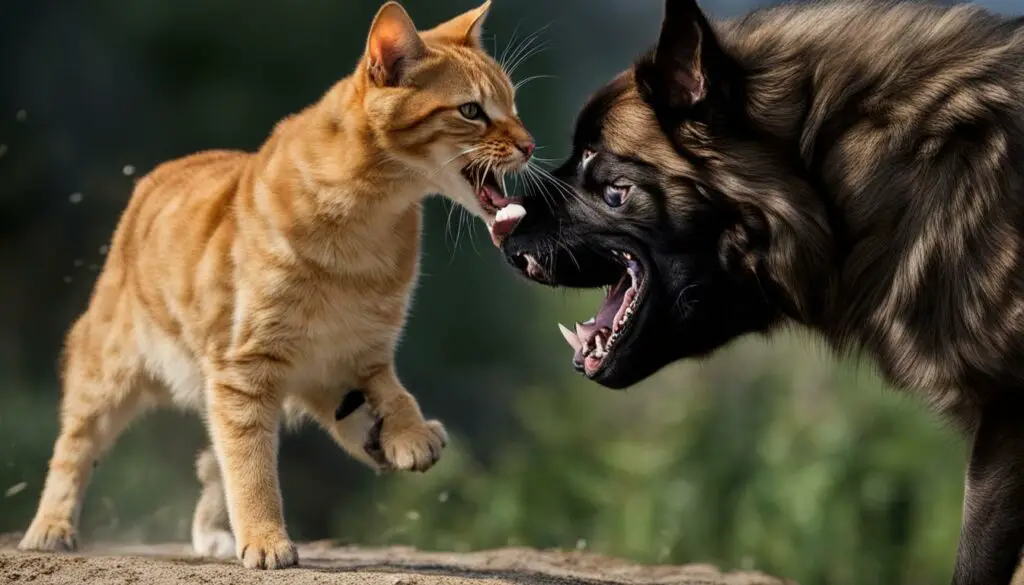
Cats and Dogs: Different Taste Preferences
When it comes to taste preferences, cats and dogs have distinct differences. While dogs can taste sweetness and umami, cats, on the other hand, cannot detect sweetness but have a strong preference for umami, the savory flavor found in meat. These preferences are rooted in their evolutionary backgrounds and dietary needs.
Cats, as obligate carnivores, have evolved to focus on meat flavors. Their taste receptors are finely tuned to detect the rich umami taste, which is abundant in protein-rich animal sources. This preference for umami reflects their evolutionary history as hunters and carnivores.
Dogs, being opportunistic feeders, have a broader range of taste preferences. They can taste sweetness, which is a characteristic feature of many fruits and carbohydrates. Additionally, dogs can also detect umami flavors, allowing them to enjoy both sweet and savory tastes in their diet.
The different taste preferences of cats and dogs stem from their unique dietary adaptations. Understanding these preferences can help pet owners make informed choices when it comes to their pets’ diets, ensuring that they provide appropriate and appealing food options that cater to their pets’ natural inclinations.

Table: Comparison of Taste Preferences in Cats and Dogs
| Taste | Cats | Dogs |
|---|---|---|
| Umami | Strong preference | Preference |
| Sweetness | Cannot taste | Can taste |
| Bitterness | Can taste | Can taste |
| Saltiness | Can taste | Can taste |
| Sourness | Can taste | Can taste |
Genetic Factors Influencing Taste Preferences
Genetic factors play a significant role in determining the taste preferences of cats and dogs. Cats, for example, have a broken gene that prevents them from detecting sweetness, but they possess taste receptors that allow them to perceive umami, the savory taste found in meat. This genetic variation explains why cats are obligate carnivores, with a strong preference for meat-based diets.
On the other hand, dogs exhibit breed-specific taste variations due to genetic differences in taste receptor genes. These variations can influence their perception of different tastes, including sweetness, umami, and other flavors. This genetic diversity might explain why some dog breeds are more selective when it comes to food, while others have a broader range of taste preferences.
Breed-Specific Taste Variations
Further research has shown that certain dog breeds possess unique taste receptor gene variants, which can influence their preference for specific flavors. For example, some breeds have a higher sensitivity to bitter tastes, which may explain why they may be more hesitant to try certain foods or treats.
To illustrate this, let’s take a look at a table showcasing some notable taste receptor gene variations and their corresponding dog breeds:
| Dog Breed | Taste Receptor Gene Variant | Taste Preferences |
|---|---|---|
| Labrador Retriever | TAS2R38 PAV/PAV | Higher sensitivity to bitter tastes |
| Beagle | TAS2R38 AVI/AVI | Lower sensitivity to bitter tastes |
| Pomeranian | TAS2R38 AVI/PAV | Moderate sensitivity to bitter tastes |
Understanding these genetic factors and breed-specific taste variations can provide valuable insights for the development of tailored pet foods and treats. By catering to the unique taste preferences of different cat and dog breeds, pet owners can ensure their furry companions receive optimal nutrition and enjoy their meals.

Genetic factors influence the taste preferences of cats and dogs, with cats lacking the ability to taste sweetness but having a strong affinity for umami. Meanwhile, dogs exhibit breed-specific taste variations, which can affect their perception of different flavors. This genetic diversity calls for a customized approach to pet food development, ensuring that each breed’s taste preferences are met, ultimately enhancing their overall dining experience.
The Evolution of Cat and Dog Taste Preferences
Taste preferences in animals are not random but shaped by their evolutionary history and dietary needs. Cats and dogs, as carnivorous animals, have developed specific taste preferences that reflect their unique evolutionary adaptations.
First and foremost, cats are obligate carnivores, meaning their bodies are designed to thrive on a meat-based diet. This has influenced their taste preferences, with a strong focus on flavors associated with meat, such as umami. Umami is a savory taste that cats can detect and appreciate, making it an essential component of their preferred flavors.
Dogs, on the other hand, are opportunistic feeders with a more varied diet. Unlike cats, dogs have a wider range of taste receptors, allowing them to perceive and enjoy a broader spectrum of flavors. They can taste sweetness, which is a taste preference often associated with carbohydrates and plant-based foods. Additionally, dogs can also appreciate umami flavors like cats.
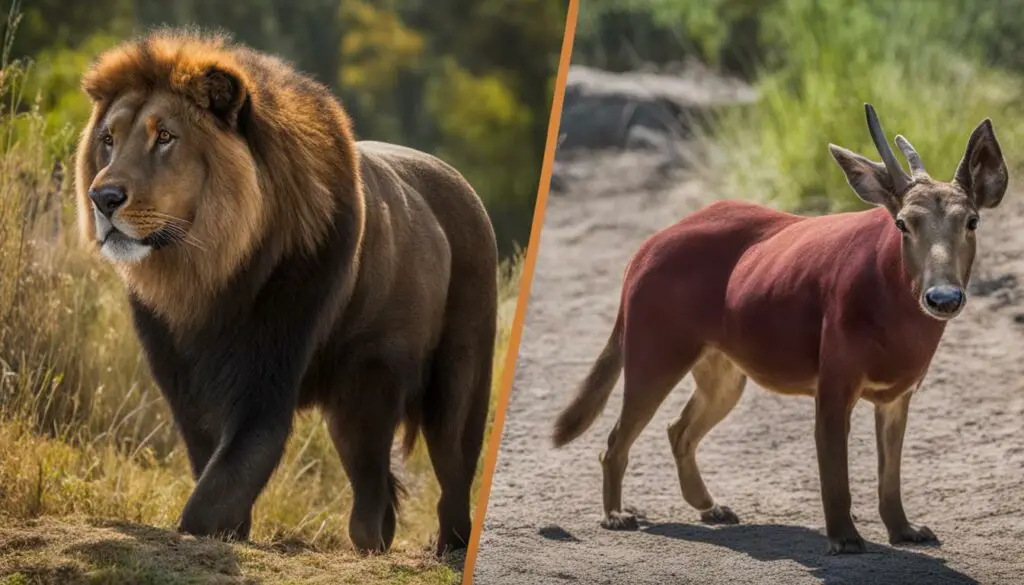
| Cat Taste Preferences | Dog Taste Preferences |
|---|---|
| Strong preference for umami | Preference for umami |
| No ability to taste sweetness | Ability to taste sweetness |
| Meat flavors are essential | Greater variety of taste preferences |
These taste preferences are deeply rooted in the natural dietary needs of cats and dogs. Cats’ evolutionary adaptation as obligate carnivores necessitates a focus on meat flavors, while dogs’ opportunistic feeding behavior has allowed them to develop a broader range of taste capabilities. Understanding these evolutionary influences can guide pet owners in providing balanced and nutritious diets that cater to their pets’ specific taste preferences and dietary requirements.
How Taste Preferences Impact Pet Care
Tailoring pet food to suit the taste preferences of cats and dogs is crucial for ensuring their overall well-being. Just like humans, our furry companions have their own unique perception of flavors, and understanding this can greatly enhance their appetite and enjoyment of their meals.

Cats, being obligate carnivores, have a strong preference for umami, the meaty and savory flavor found in their natural prey. Dogs, on the other hand, have a wider range of taste preferences, including a sensitivity to sweetness. These taste differences are attributed to their distinct dietary needs and evolutionary adaptations.
To ensure that pets consume their food and medications willingly, developing palatable options that align with their taste preferences is essential. This can involve adjusting the flavors and textures to cater to their preferences, making the experience more enjoyable for them. By taking their taste preferences into consideration, pet owners can enhance their pets’ quality of life and maintain their overall health.
Key Takeaways:
- Taste preferences in cats and dogs are influenced by their evolutionary background and dietary needs.
- Cats have a preference for umami flavors, while dogs have a wider range of taste preferences.
- Tailoring pet food and medications to suit their taste preferences can improve their appetite and overall well-being.
Table: Comparison of Taste Preferences in Cats and Dogs
| Cats | Dogs | |
|---|---|---|
| Preference for Sweetness | No preference, unable to taste sweetness | Sensitive to sweetness |
| Preference for Umami | Strong preference | Varying preference |
| Preference for Other Flavors | Less pronounced | Wide range of preferences |
Understanding the taste preferences of our pets provides valuable insights for their overall care. By tailoring their food and medications to suit these preferences, pet owners can ensure that their furry friends are not only well-fed, but also enjoy their meals to the fullest.
The Importance of Emotional Well-being in Cats and Dogs
Understanding and promoting the emotional well-being of our beloved pets, such as cats and dogs, is crucial for their overall health and happiness. Just like humans, animals experience a wide range of emotions, from joy and excitement to fear and anxiety. As responsible pet owners, it is our duty to create an environment that supports their emotional needs and fosters a strong bond between them and us.
Cats and dogs rely on us for their emotional stability, and there are several key factors to consider in ensuring their well-being. Providing environmental enrichment is essential for both species. This can include offering toys, scratching posts, and hiding places for cats, as well as engaging in regular playtime and exercise sessions with dogs. A stimulating environment helps prevent boredom and promotes positive mental health.
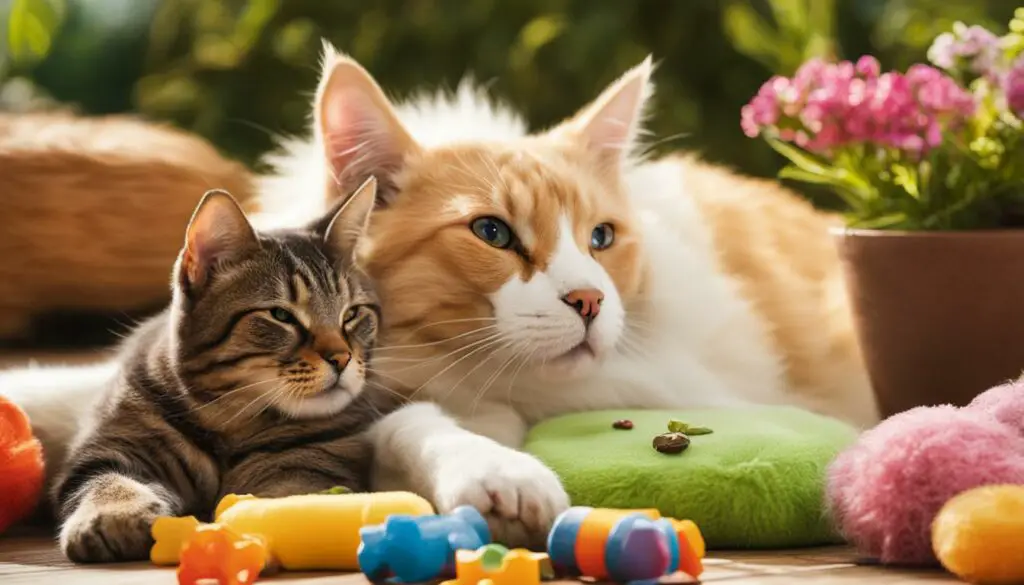
Proper socialization is also crucial for the emotional health of cats and dogs. Early interactions and positive experiences with other animals, humans, and various environments help them to feel more comfortable and confident. This can be achieved through gentle exposure to different situations and gradual introductions to new people and animals.
Quote:
“The bond between cats and dogs and their human companions is built on trust, affection, and understanding.”
Establishing consistent routines is another important aspect of maintaining emotional well-being in pets. Cats and dogs thrive on predictability and structure. Regular feeding, exercising, and playtime schedules not only provide a sense of security but also strengthen the bond between pets and their owners.
In conclusion, understanding and nurturing the emotional well-being of cats and dogs is essential for their overall health and happiness. By providing environmental enrichment, promoting proper socialization, and establishing consistent routines, we can create a loving and harmonious environment for our furry friends. Remember, the bond we share with our pets is built on trust, affection, and understanding, and by prioritizing their emotional needs, we can create a strong and fulfilling relationship.
Training Cats and Dogs to Live in Harmony
Managing the relationship between cats and dogs can be a challenging task, but with the right training and techniques, they can learn to coexist peacefully. By understanding their behavior and implementing behavior modification strategies, pet owners can create a harmonious environment for their furry companions.
One of the key aspects of training cats and dogs to live together is providing them with their own space and resources. This includes separate feeding areas, litter boxes, and resting spots. By giving each pet their own designated areas, it helps reduce competition and potential conflicts.
Positive reinforcement is an effective training method for both cats and dogs. Rewarding desirable behaviors, such as calm and friendly interactions, can help encourage positive associations between them. It’s important to use treats, praise, and playtime to reinforce good behavior and redirect any negative or aggressive actions.
Understanding cat and dog body language is crucial when training them to live together. Dogs may exhibit signs of fear or anxiety, such as cowering or growling, while cats may puff up their fur or hiss when they feel threatened. By recognizing these signals, pet owners can intervene and prevent potential conflicts before they escalate.
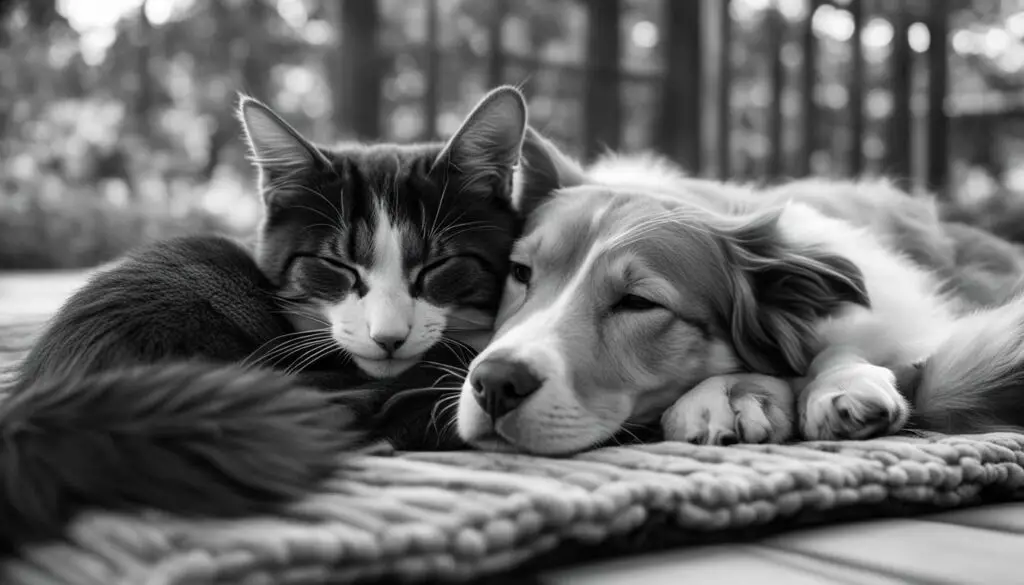
Key Training Tips:
- Provide separate spaces and resources for cats and dogs
- Use positive reinforcement to reward desirable behavior
- Recognize and understand cat and dog body language
- Seek professional help if needed for behavior modification
By following these training techniques and consistently reinforcing positive behavior, cats and dogs can learn to coexist and form a strong bond with each other. Patience and consistency are key, and it’s important to remember that every pet is unique and may require different approaches. With time and effort, pet owners can create a loving and harmonious environment for their furry friends.
Dispelling Misconceptions about Cats
There are many misconceptions about cats that often lead to misunderstandings and misinterpretations of their behavior. It’s important to debunk these misconceptions and gain a deeper understanding of cats to build stronger relationships with them. Contrary to popular belief, cats are not solely independent and aloof animals, but rather they form strong bonds with their human companions.
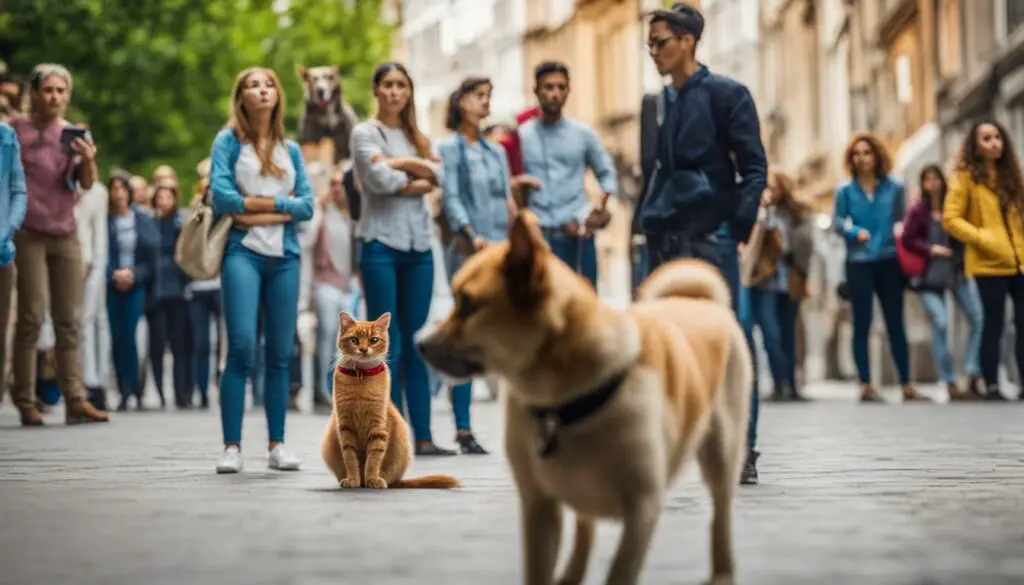
Cats have their own unique ways of showing affection and establishing a connection. They may rub against their owners, purr, or knead on their laps. These behaviors are a display of trust, love, and a desire for companionship. While cats may not exhibit the same level of excitement and outward affection as dogs, their love and devotion are equally genuine.
“Cats are connoisseurs of comfort.” – James Herriot
Understanding cat behavior is essential in dispelling misconceptions. Cats are territorial creatures by nature, and they require a sense of security and familiarity in their environment. They may display independence as a way to protect themselves and assess potential threats. However, this does not mean that they do not seek human interaction and companionship. They simply have their own unique ways of expressing their need for love and attention.
The Future of Feline Psychology
Understanding our feline companions goes beyond unraveling their mysterious behavior and preferences. Ongoing advancements in feline psychology offer exciting possibilities for improving the well-being of cats and enhancing their relationships with humans. Researchers and experts are delving deeper into the cognitive abilities, emotions, and social dynamics of cats, shedding light on their inner world.
Exploring feline psychology allows us to gain insights into how cats perceive and interact with the world around them. By understanding their cognitive processes, we can develop innovative strategies to enrich their environment and stimulate their minds. This knowledge helps us design environments that cater to their natural instincts and needs, promoting their overall well-being.
Moreover, an in-depth understanding of feline psychology paves the way for building stronger cat-human relationships. By recognizing and respecting their unique communication styles and preferences, we can establish a deeper connection with our feline companions. This strengthens the bond of trust and facilitates a harmonious coexistence, fostering a mutually fulfilling relationship.

Embracing the advancements in feline psychology opens up a world of possibilities for improving the lives of our beloved cats. By combining scientific knowledge with compassionate care, we can create an environment that supports their physical, mental, and emotional needs. The future holds great promise for enhancing the well-being of cats and deepening the connections we share with them.
Conclusion
Understanding why cats hit dogs requires considering various factors such as fear, insecurity, and the instinct to assert dominance. Cats may bully dogs as a result of feeling threatened, lacking socialization, or seeking attention. By understanding their behavior, taste preferences, and emotional well-being, pet owners can create a harmonious environment and build a strong bond between their cats and dogs.
Proper training, management, and care are essential for ensuring the well-being of both pets. Providing cats and dogs with resources, positive reinforcement, and a safe environment can help prevent conflicts. It is important to focus on gentle training methods that take into account their behavior and body language.
Additionally, considering the genetic and evolutionary factors that influence cats’ and dogs’ taste preferences can aid in developing pet food and medicines that are palatable to them. Adjusting flavors based on their preferences and dietary needs can improve their appetite and overall well-being.
Ultimately, creating a harmonious living situation for cats and dogs involves understanding their individual needs and behaviors. By taking the time to learn about their instincts, emotions, and communication, pet owners can foster a positive and rewarding relationship between their furry companions.
FAQ
Why do cats bully dogs?
Cats may bully dogs out of fear, insecurity, or a desire for attention. They may also feel threatened, lack proper socialization, or want to establish dominance.
How can I prevent cat-dog conflicts?
Understanding the reasons behind cat-dog conflicts can help prevent them. Providing proper socialization, managing their environment, and addressing any underlying issues can create a harmonious living situation.
What influences taste preferences in cats and dogs?
Taste preferences in cats and dogs are genetically influenced. Cats cannot taste sweetness but have a preference for umami, while dogs can taste sweetness and umami. These taste preferences are related to their dietary needs and evolutionary background.
How can understanding taste preferences improve pet food?
Understanding taste preferences in cats and dogs can help in the development of more palatable pet foods. Adjusting flavors based on their preferences and dietary needs can improve their appetite and overall well-being.
How can I ensure emotional well-being in cats and dogs?
Environmental enrichment, proper socialization, and consistent routines are essential for the emotional well-being of cats and dogs. The bond between cats and dogs and their human companions is built on trust, affection, and understanding.
How can I train cats and dogs to coexist peacefully?
Training cats and dogs to live in harmony requires providing them with resources, positive reinforcement, and a safe environment. Gentle methods and understanding their behavior and body language are crucial for successful training.
Are cats really independent and aloof?
Cats are often misunderstood as independent and aloof animals. However, they form strong bonds with their human companions and display affection in their own unique ways.
What does the future hold for feline psychology?
Ongoing research in feline psychology holds the potential for enhancing our understanding of cats’ cognitive abilities, emotions, and social dynamics. This knowledge can lead to improved relationships between cats and humans and better overall well-being for cats.
Source Links
- https://www.hyaenidae.org/unraveling-the-mystery-of-cat-on-dog-bullying-understanding-the-causes-and-finding-solutions/
- https://www.wfla.com/bloom-tampa-bay/bloom-health-and-wellness/unraveling-the-enigma-understanding-the-feline-mind/
- https://www.nationalgeographic.com/premium/article/cats-dogs-taste-genetics-umami-sweet

